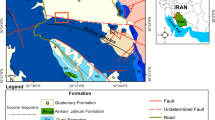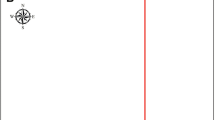Abstract
Ground-penetrating radar (GPR) investigations were carried out in a costal terrain for locating freshwater pockets at Vizag Steel Plant (VSP), Vishakapatnam, Andhra Pradesh, India. The entire area is underlain by recent alluvial which consists of sand, clay, and silt with basement as Kondalitic rock formation. GPR is a surface geophysical method that depends on the emission, transmission, reflection, and reception of electromagnetic pulses and can produce continuous high-resolution profiles of the subsurface rapidly and efficiently at any desired location. The interpretation of radar records requires little or no processing. Based on GPR investigations, four locations were recommended for drilling of bore well at VSP, Vishakapatnam. The drilled bore well was found to yield good water to meet the demand of VSP, Vishakapatnam. Hydrochemical study reveals that the total dissolved solids (TDS) and chloride concentration range from 189 to 3,398 and 5 to 1,610 mg/l. The eastern and northeastern parts of the study area have elevated concentration of TDS and chloride, indicating intrusion of saline water. TDS concentration of drilled bore well was found to range from 200 to 700 mg/l. The observed yield of drilled bore wells ranges from 1,300 to 4,900 lph.








Similar content being viewed by others
References
Annan AP (1999) Practical processing of GPR data; Sensors and software, Ontario
Annan AP, Cosway SW (1994) GPR frequency selection. 5th Int. Con. on Ground Penetrating Radar, Waterloo, Ontario, 747-760
Aqeel A, Anderson N, Maerz N (2014) Mapping subvertical discontinuities in rock cuts using a 400-MHz ground penetrating radar antenna. Arab J Geosci 7(5):2093–2105
Baker PL (1991) Response of ground-penetrating radar to bounding surfaces and lithofacies variations in sand barrier sequences. Explor Geophys 22:19–22
Beres M, Haeni FP (1991) Application of ground penetrating radar methods in hydrogeologic studies. Ground Water 29:375–386
Beres M, Green A, Huggenberger P, Horstmeyer H (1995) Mapping the architecture of glaciofluvial sediments with 3D georadar. Geology 23:1087–1090
Buynevich IV, FitzGearald DM (2003) High resolution subsurface (GPR) imaging and sedimentology of coastal ponds, Maine, USA: implications for Holocene back-barrier evolution. J Sediment Res 3:559–571
Collinson JD, Thompson DB (1989) Sedimentary structures, 2nd edn. Unwin Hyman, London, p 207
Conyers LB, Goodman D (1997) Ground penetrating radar: an introduction for archaeologists, AltaMira Press
Corbeanu RM, Soegaard K, Szerbiak RB, Thurmond JB, McMechan GA, Wang D, Snelgrove S, Forster CB, Menitove A (2001) Detailed internal architecture of a fluvial channel sandstone determined from outcrop, cores and 3-D ground penetrating radar: Example from the middle Cretaceous Ferron Sandstone, east-central Utah. AAPG Bull 85:1583–1608
Davis JL, Annan AP (1989) Ground penetrating radar for high-resolution mapping of soil and rock stratigraphy. Geophys Prospect 37:531–551
de Menezes Travassos J, de Tarso Luiz Menezes P (2004) GPR exploration for groundwater in a crystalline rock terrain. J Appl Geophys 55:239–248
Doolittle JA, Jenkinson B, Hopkins D, Ulmer M, Tuttle W (2006) Hydropedological investigations with GPR: estimating water-table depths and local groundwater flow pattern in areas of coarse textured soils. Geoderma 131:317–329
El-Behiry MG, Hanafy SM (2013) Imaging soil moisture using GPR tomo-graphy and reflection field experiments. Arab J Geosci 6:3493–3503
GSI (2001) Geological Survey of India, District Resource Map, Vishakapatnam District, Andhra Pradesh
Hammon WS III, Zeng X, Corbeanu RM, Mcmechan GA (2002) Estimation of the special distribution of fluid permeability from surface and tomographic GPR data and core, with a 2-D example from the ferron sandstone, Utah. Geophysics 67:1505–1515
Hanafy S, Al Hagrey SA (2006) Ground-penetrating radar tomography for soil-moisture heterogeneity. Geophysics 71(1):K9–K18
Hubbard SS, Peterson JE Jr, Majer EL, Zawislanski PT, Williams KH, Roberts J, Wobber F (1997) Estimation of permeable pathways and water content using tomographic radar data. Lead Edge 16:1623–1628
Huisman JA, Hubbard SS, Redman JD, Annan AP (2003) Measuring soil water content with ground penetrating radar: a review. Vadose Zone J 2:476–491
Jol HM, Lawton DC, Smith DG (2002) Ground penetrating radar: 2-D and 3-D sub-surface imaging of a coastal barrier spit, Long beach, WA, USA. Geomorphology 53:165–181
King W (1986) The geological sketch of Vishakapatnam district. Rec Geol Surv India 19:42–156
Knight R (2001) Ground penetrating radar for environmental applications. Annu Rev Earth Planet Sci 29:229–255
Kowalsky MB, Finsterle S, Peterson J, Hubbard S, Rubin Y, Major E, Ward A, Gee G (2005) Estimation of field-scale soil hydraulic and dielectric parameters through joint inversion of GPR and hydrological data. Water Resour Res 41:W11425
Lambot S, Antoine M, van den Bosch I, Slob EC, Vanclooster M (2004) Electromagnetic inversion of GPR signals and subsequent hydrodynamic inversion to estimate effective Vadose Zone hydraulic properties. Vadose Zone J 3:1072–1081
Mahadevan C, Sathapathi N (1949) The origin of Waltair Highlands. India Geogr J 24:1–26
Maurya DM, Goyal B, Patidar AK, Mulchandani N, Thakkar MG, Chamyal LS (2006) Ground penetrating radar imaging of two large sand blow craters related to the 2001 Bhuj earthquake, Kachchh, Western India. J Appl Geophys 60:142–152
Natarajan V, Nanda K, Subrahmanyam MR (1979) Geology and its influence on physical environment of Vishakapatnam city and its neighborhood. Workshop on Integrated Resource Evaluation for Vishakapatnam Urban Growth Center. 2: 1-10
Neal A (2004) Ground-penetrating radar and its use in sedimentology: principles, problems and progress. Earth Sci Rev 66:261–330
Neal A, Roberts CL (2000) Application of ground penetrating radar (GPR) to sedimento-logical, geomorphological and geoarchaeological studies in coastal environments; In:Coastal and Estuarine Environments; Sedimentology, Geomorphology and Geo-archaeology (eds) Pye K, Allen JRL; Geol. Soc. London Spec. Publ. 175:139-171
Neal A, Richards J, Pye K (2003) Sedimentology of coarse clastic beach ridge deposits, Essex, Southeast England. Sed Geol 162:167–198
Odah H, Ismail A, Elhemaly I, Anderson N, Abbas AM, Shaaban F (2013) Archaeological exploration using magnetic and GPR methods at the first court of Hatshepsut Temple in Luxor, Egypt. Arab J Geosci 6(3):865–871
Prithiraju KN, Vaidyanadhan R (1978) Geomorphology of Vishakapatnam, Andhra Pradesh. J Geol Soc India 19(10):26–34
Rashed MA, Al-Garni MA (2013) On the application of GPR for locating underground utilities in urban areas. Arab J Geosci 6(9):3505–3511
Reynolds JM (1997) An introduction to applied and environmental geophysics. Wiley, Chichester
Sankaran S, Gurunadha Rao VVS, Ratnakar Dhakate, Ramesh G, Satish Kumar V (2012) Identification and assessment of groundwater resource availability in the township and plant premises of Visakhapatnam Steel Plant (VSP) and suggestion of measures for sustaining groundwater yield for future, NGRI Tech Rep. No. NGRI-2012-Environ-797, 1-46
Shaaban F, Ismail A, Massoud U, Mesbah H, Lethy A, Abbas AM (2013) Geotechnical assessment of ground conditions around a tilted building in Cairo, Egypt using geophysical approaches. Arab J Geosci 6(12):4961–4972
Shukla SB, Patidar AK, Bhatt N (2008) Application of GPR in the study of shallow subsurface sedimentary architecture of Modwa spit, Gulf of Kachchh. J Earth Syst Sci 117(1):33–40
Sridhar A, Patidar A (2005) Ground penetrating radar studies of a point bar in the Mahi river Basin, Gujarat. Curr Sci 89:183–189
Van Dam RL, Schlager W (2000) Identifying causes of GPR reflections using time-domain refletometry and sedimentological analysis. Sedimentology 47:435–449
Van Overmeeren RA (1994) Georadar for hydrogeology. First Break 12(8):401–408
Van Overmeeren RA (1998) Radar facies of unconsolidated sediments in The Netherlands: a radar stratigraphy interpretation method for hydrogeology. J Appl Geophys 40:1–18
WHO (1993) Guidelines for drinking water quality. Recommendations 2nd edn, Vol. 1. Geneva, 130pp
Wollschlaeger U, Roth K (2005) Estimation of temporal changes of volumetric soil water content from GPR reflections. Subsurf Sens Technol Appl 6:207–218
Wollschlaeger RK, Cheng ZH, Zhang JB (2004) Exploring soil layers and water tables with ground penetrating radar. Pedosphere 13:273–282
Acknowledgments
Authors express their thanks to Director, NGRI, Hyderabad for his continuous support for the research activity. Authors are also grateful to the staff of Water Management Department, VSP, Vishakapatnam for providing necessary support throughout investigations. Authors are also thankful to honorable reviewers for giving their valuable suggestions and comments for the improvement of the scientific content of the manuscript. Authors are thankful to the Editor of the journal for his kind support and encouragement.
Author information
Authors and Affiliations
Corresponding author
Rights and permissions
About this article
Cite this article
Dhakate, R., Amarender, B., Kumar, V.S. et al. Application of ground-penetrating radar for identification of groundwater resources in a coastal terrain. Arab J Geosci 8, 4703–4715 (2015). https://doi.org/10.1007/s12517-014-1567-8
Received:
Accepted:
Published:
Issue Date:
DOI: https://doi.org/10.1007/s12517-014-1567-8




